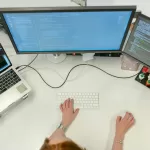Digital twins can be used to replicate procedures even before they find use in the real environment. This assures businesses to obtain the greatest results. Creating virtual copies of actual assets, systems, or even whole businesses enables businesses to quickly spot problems, test new ideas, and hone their plans. From manufacture to healthcare, this technology helps people in many different fields come up with new ideas. It is becoming ever more important as more businesses go online.
Why are digital twins required?
A “digital twin” is a computer model meant to closely reflect the real-world or system. Sensor-based real-time data collecting contributes to produce this dynamic digital picture. Fresh ideas are something businesses may grab and test without facing any risk. They are used in business innovation to forecast consumer sentiment, machine performance, and system failures. They give companies new ideas for conducting their operations, cost control, and coordination of activities.
Important Applications for Digital Twins
They are driving fresh ideas in many different areas by arming them with more knowledge and better control over how they run their companies. These are few usual uses for it:
-
Past performance-based automotive maintenance
It has changed the way companies applying tools—like manufacturing, power, and transportation—do their business. They let companies track equipment in real time and warn when sections are about to break. This method lowers costly downtime and increases equipment lifetime, so saving a lot of money.
Digital twins let airlines track aircraft performance and spot problems before they show up. This guarantees airplane safety, guarantees repair planning, and helps to lower delays.
-
Intelligent instruments and better ways of application
Companies which want to keep competitive have to simplify their processes. Digital twins help them to test and improve processes without stopping them. They can develop phoney copies of their supply chains, marketing networks, or manufacturing lines to find areas where things aren’t operating as well as they should and figure out how to fix them.
Digital twins offer even another way to make smart systems better. Businesses who connect real-world hardware to virtual models can streamline processes and immediately apply changes based on current situation. They allow businesses in the logistics industry change delivery routes based on real-time traffic data. This will make them happy with the business and the services.
-
Virtual models that help to create objects
Usually for new items, making physical prototypes—which can be rather expensive and time-consuming—is necessary. Virtual prototypes created with this help to speed up the planning process. First of all, these models help engineers find possible design flaws. This simplifies the road to market and lowers the necessary number of corrections needed.
In the automotive business, digital twins are used to build models of how a car might perform on different types of roads and at different temperatures. This lets the creators change their designs before they are built, so guaranteeing their quality of work and safety.
-
New ideas and better client service in companies
The way businesses engage with their customers is changing as a result of this, particularly in retail. Some companies use computer models to better know the type of their customers are. This helps them to design retail layouts and more tailored marketing strategies.
To establish online changing rooms where customers may test out products, fashion companies use digital twins in one technique. This not only makes shopping fun but also makes consumers happy and lessens returns.
For Real Time Digital Twins, what exactly it does?
Real-time scanning technologies underlie digital twin technology essentially. Monitors built inside assets track their statuses, utilization, and performance in addition to their connected data. The virtual model then gets this data entered into. The twin then goes over the material looking for trends. They try to forecast what will happen and provide ideas on what need to be done. This loop of information guarantees that digital twins are always accurate and reflect reality as it is.
Digital twins let a company in the energy sector quickly change output depending on demand and monitor power networks. It performs better, keeps the power consistent, and consumes less energy.
Using Digital Twins without Problems
Companies find it challenging to deploy digital twins even though they have many uses. One usually comes into the need of a lot of excellent knowledge. If sufficient and consistent data is not obtained, digital twins may not yield trustworthy results. Digital infants can be challenging to operate with current technology and systems; moreover, their cost can be exorbitant.
Safety is another issue since digital twins frequently hold private information. Companies have to protect their data from internet threats. They could thus have to track and encrypt data using advanced technologies.
Companies now, at last, want skilled specialists to interact with and evaluate digital twins. They could be hired by you or trained as they know how to use both real and virtual tools.
What digital twins and fresh ideas have ahead?
Digital twins have a great future in business innovation; various themes will most likely influence their evolution. More and more clever computers and digital twins are being employed together. Artificial intelligence twin driven will be able to learn from data over time. This will help people to make more accurately personal guesses and conclusions.
Another evolution is the use of this to support lifespan. Companies can learn better how to run by seeing how their activities affect the environment. Like a manufacturing company would use a digital twin to test many strategies to produce goods with less energy or waste consumption.
Growing with the Internet of Things (IoT) will be more tools able to link to digital twins. Their use will grow as a result. Digital twins find two of their various applications in integrating offices and creating smart communities.
Finally…
Using digital twins changes how companies run, plan, and improve their processes. This have various applications among smart systems, improved consumer experiences, maintenance planning, and virtual sampling. As they continue to use real-time modeling and process optimization, digital twins will become more and more crucial for businesses that want to stay ahead of the competition and support innovation.
Nonetheless, issues with data quality, communication, and safety have to be resolved before this technology can really shine. This will become ever more important as IoT, artificial intelligence, and growing environmental improvements shape society. This will allow companies create innovative ideas in the next years.









